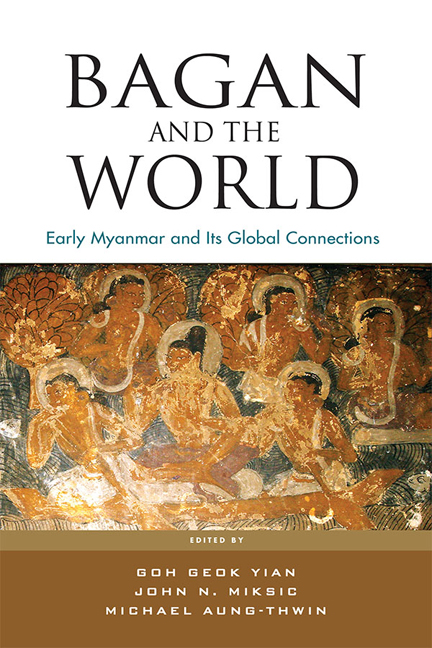Book contents
- Frontmatter
- Contents
- Preface
- Contributors
- 1 Keynote: The Myth of “Splendid Isolation”
- 2 Analysis of Construction Technologies in Pyu Cities and Bagan
- 3 Khraung-kaik Pitaka-taik: 16th-Century Repositories for Buddhist Scriptures in Mrauk-U
- 4 Religious Symbols as Decorations on the Sikhara of Ancient Monuments in the Late Bagan Period
- 5 The Viṣṇu on Garuḍa from the Nat Hlaung Kyaung Temple, Bagan
- 6 A Thousand Years before Bagan: Radiocarbon Dates and Myanmar's Ancient Pyu Cities
- 7 Ta Mok Shwe-Gu-Gyi Temple Kyaukse and Bagan
- 8 Silver Links! Bagan–Bengal and Shadowy Metal Corridors: 9th to 13th Centuries
- 9 Positioning Bagan in the Buddhist Ecumene: Myanmar's Trans-Polity Connections
- 10 Orthogeneity, Settlement Patterns and Earthenware Pottery Distribution in Bagan
- Index
- Miscellaneous Endmatter
5 - The Viṣṇu on Garuḍa from the Nat Hlaung Kyaung Temple, Bagan
Published online by Cambridge University Press: 01 February 2018
- Frontmatter
- Contents
- Preface
- Contributors
- 1 Keynote: The Myth of “Splendid Isolation”
- 2 Analysis of Construction Technologies in Pyu Cities and Bagan
- 3 Khraung-kaik Pitaka-taik: 16th-Century Repositories for Buddhist Scriptures in Mrauk-U
- 4 Religious Symbols as Decorations on the Sikhara of Ancient Monuments in the Late Bagan Period
- 5 The Viṣṇu on Garuḍa from the Nat Hlaung Kyaung Temple, Bagan
- 6 A Thousand Years before Bagan: Radiocarbon Dates and Myanmar's Ancient Pyu Cities
- 7 Ta Mok Shwe-Gu-Gyi Temple Kyaukse and Bagan
- 8 Silver Links! Bagan–Bengal and Shadowy Metal Corridors: 9th to 13th Centuries
- 9 Positioning Bagan in the Buddhist Ecumene: Myanmar's Trans-Polity Connections
- 10 Orthogeneity, Settlement Patterns and Earthenware Pottery Distribution in Bagan
- Index
- Miscellaneous Endmatter
Summary
From Bagan to St Petersburg
For nearly seventy years, four Burmese stone sculptures dating to the 11th–12th centuries have been in storage at the Hermitage Museum, St Petersburg. They arrived in Russia after World War II, part of a large group of Asian art objects (from India to Japan and Indonesia) from two institutions in Berlin, the Museum für Volkerkunde and the Museum für Ostasiatische Kunst. It was only after the radical political changes in the Soviet Union in the early 1990s that, after a long period of obfuscation regarding their background, Russia and Germany were able to begin to work together, and with other specialists, on these collections.
The Burmese sculptures comprise three images depicting events from the life of the Buddha: the cutting of the hair in preparation for his life as an ascetic; the Naga King Mucalinda sheltering him from a storm in the sixth week after the Enlightenment; and the taming of the raging elephant Nālāgiri. We discussed these images at the EURASEAA 14 Conference in Dublin in September 2012 and our findings will be published in the conference proceedings. The fourth image, examined here, represents Viṣṇu on Garuḍa, Viṣṇu Garuḍāsana.
These sculptures were sent to the Museum für Volkerkunde between 1894 and 1896 by a German geologist and palaeontologist, Friedrich (Fritz) Wilhelm Nötling (1857–1928), who at the time was employed by the Geological Survey of India and was working at the Yenangyaung oil fields near Bagan. Nötling studied geology and related subjects before graduating in 1885, after which he worked as a private docent (tutor) at the University of Königsberg. In the same year, he was assigned by the Berlin Academy of Sciences to go on a mission to Palestine, and he subsequently published his first paper for the Geological Survey of Prussia in 1886. Until the University Reforms of the late 1900s, palaeontology was not taught at English universities, and the Geological Survey of India from time to time found it necessary to resort to Germany to find suitable people to fill palaeontological posts. In January 1887 Nötling sailed to Calcutta and served in the Geological Survey until 1903. He became a prolific researcher on geological, paleontological, prehistoric and ethnological subjects and published over forty papers and three books (Struwe 2006, p. 33).
- Type
- Chapter
- Information
- Bagan and the WorldEarly Myanmar and Its Global Connections, pp. 66 - 87Publisher: ISEAS–Yusof Ishak InstitutePrint publication year: 2017

